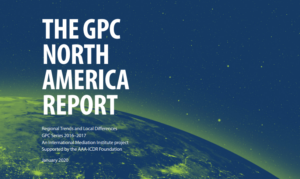
In his blogpost of December 2019, Alan Limbury gives us a thoughtful reminder of the history and background to the GPC.
I too was in the audience at London’s historic Guildhall on October 29, 2014, when IMI gathered together users of mediation, lawyers, mediators, academics and others involved in dispute resolution processes and began an exploration that led to the GPC Series conducted between March 2016 and July 2017 and travelling through 28 events in 22 countries.

I have followed the Series carefully, attending the first in Singapore, the last when it returned to the Guildhall and the Sydney event somewhere in the middle.
Conceived and driven by IMI with the support of sponsors from around the globe, the Series was extraordinarily ambitious for a range of reasons – most remarkable being the ambition ‘to generate conversation and collect actionable data that could be used to shape the future of commercial dispute resolution (DR) and access to justice’.
The vision contemplated the collection of both quantitative and qualitative data – a bold ambition indeed. The qualitative and quantitative data were collected on the day via specially developed software accessed by participants. The results from the quantitative data, that is the 20 multiple choice questions, were displayed immediately in charts generated by the software, provoking significant discussion among participants.
The results of the qualitative data, that is the 13 open text questions, took significantly longer to analyse – for very good reason given the extraordinary rigour and precision required for analysis of this kind.
The significance of the report.
 The North America Report consolidates 7 individual reports of events in the series across North America. It is the result of rigorous and ground-breaking qualitative research on the data emerging from the open text questions. As the Report notes: ‘The GPC generated considerable data using methods not previously considered, in ways not previously possible, and at an unprecedented scale across the globe….and is the largest undertaking of its kind in the history of commercial dispute resolution’.
The North America Report consolidates 7 individual reports of events in the series across North America. It is the result of rigorous and ground-breaking qualitative research on the data emerging from the open text questions. As the Report notes: ‘The GPC generated considerable data using methods not previously considered, in ways not previously possible, and at an unprecedented scale across the globe….and is the largest undertaking of its kind in the history of commercial dispute resolution’.
The call to action identified 6 top priorities. We will see a lot of attention paid to them as the Report gains the exposure it deserves. But there is a lot more.
My key take-outs:
• Quantitative and qualitative research are very different.
Quantitative research matters. The results are relatively easy to consolidate and technology makes the process very efficient. Early release of results supports stakeholders seeking quick answers. However multiple choice questions reflect closed questions devised by their authors with a pre-determined choice of responses. There is always the risk that those answering the questions are choosing the best from a limited set of answers rather than making a ‘real’ choice. Open text questions offer some structure but allow what participants really think to emerge. This can produce the expected and the unexpected – telling the participants’ stories. It can also confuse us, producing richer information which apparently contradicts the quantitative data.
However the deep-dive into data required by qualitative research is extremely complex and time consuming. We had to wait a long time for this report to be produced so meticulously and now it is in our hands we can say it was worth it!
• We now have a new model of what qualitative research can do and how to go about it.
The methodology used to analyse the data and produce the report is not new but it is new to the DR arena. It is a result of the rich cross-disciplinary research experience of the authors of the report, Danielle Hutchinson and Emma-May Litchfield of Resolution Resources. It promises a new model of interdisciplinary thinking not constrained by academic backgrounds. It models how we can draw on psychometrics that have proven so robust and effective in the fields of education and psychology – a great addition to the DR research repertoire.
• It is time to lose the ‘A’ in ADR in the pursuit of a ‘party-centric approach to dispute resolution’
This was one of the top priorities identified in the call to action. It struck a particular chord with me as I have spent many sessions with my university students dealing with the challenge of answering the question ‘What is ADR and where does it fit?’ Many of us have struggled for a long time to take the ‘A’ out of ADR. We have tried using ‘appropriate’ and we have tried to replace ‘A’ with ‘C’ for consensual, but these attempts have not been successful. This report suggests that DR is the appropriate acronym for the suite of services covering adjudicative and non-adjudicative processes. Choosing the process or combination of processes that best meets what parties ‘need, want and expect’ is the element that provides the opportunity for a party-centric approach even if the process itself, such as litigation, is not seen as party-centric.
• We are not a unified DR community
The report consolidates findings from the 7 individual reports from
Austin, Baltimore, Los Angeles, Miami, New York, San Francisco and Toronto. Whilst the 6 elements of the call to action appear consistently, diving deeper into the individual reports I was struck by the significant differences in the details of practices and perceptions.
My take away is that we are a collection of individuals who have quite unexpected differences. The 7 individual reports demonstrate we are not united.
Our differences are likely to persist and it would be easy to see this as an impediment to collegiality. Our challenge is to build ‘an ability to deal well with differences’ – the definition of a good working relationship from Harvard’s Program on Negotiation.
What’s next?
I am still digesting the Report and I am sure I will continue to find more treasure.
I also expect more blogposts continuing to explore this very important research.
May the conversation continue and heartiest congratulations to IMI and Resolution Resources.
For more information about the GPC and its sponsors visit the IMI website.
________________________
To make sure you do not miss out on regular updates from the Kluwer Mediation Blog, please subscribe here.



A fabulous piece, Rosemary – thank you!